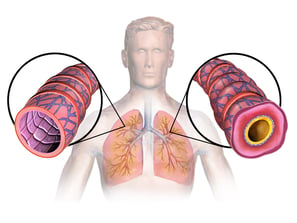Reactive Airways Dysfunction Syndrome (RADS)
Imagine taking a deep breath, only to be met with a sudden, unyielding tightness in your chest. This is the unsettling reality for individuals grappling with Reactive Airways Dysfunction Syndrome, or RADS. Let's delve into this condition, exploring its origins, symptoms, and the path to recovery.
RESPIRATORY
Rishwin A R
2/19/20253 min read


What is RADS?
Reactive Airways Dysfunction Syndrome (RADS) is an asthma-like condition that emerges abruptly following exposure to high levels of irritating substances such as gases, vapors, or fumes. Unlike traditional asthma, which often develops over time due to allergens or genetic factors, RADS strikes swiftly after a single, significant exposure to respiratory irritants.
The Culprits: What Triggers RADS?
The onset of RADS is typically linked to inhaling high concentrations of irritants. Common offenders include:
Chemical fumes: Exposure to substances like chlorine, ammonia, or sulfur dioxide.
Smoke: Inhalation of dense smoke from fires or industrial sources.
Vapors: Contact with volatile organic compounds in poorly ventilated areas.
These exposures often occur in occupational settings, putting workers such as firefighters, industrial laborers, and cleaners at risk. Accidental exposure in public spaces can also be a trigger.
Recognizing the Symptoms
RADS presents symptoms similar to asthma, though it lacks a prior history of airway hyperresponsiveness. Key symptoms include:
Persistent cough: A nagging, dry cough that worsens with exposure to irritants.
Wheezing: A whistling sound during breathing, indicating airway obstruction.
Shortness of breath: Difficulty breathing, especially with exertion.
Chest tightness: A constricting sensation that can be distressing.
Symptoms typically appear within 24 hours of exposure and may persist for months or even years without proper management.
Diagnosis: Pinning Down the Cause
Diagnosing RADS requires a detailed clinical history and objective lung function tests. Physicians assess:
Exposure history: Identifying a single, high-level irritant exposure.
Pulmonary function tests (PFTs): Assessing airflow obstruction and reversibility.
Bronchial challenge tests: Evaluating airway hyperresponsiveness in borderline cases.
RADS is a clinical diagnosis, meaning there is no specific laboratory test to confirm its presence.
Treatment and Management
Since RADS mimics asthma, its treatment revolves around controlling symptoms and preventing further airway irritation. Strategies include:
Bronchodilators: Medications like albuterol help open airways and ease breathing.
Corticosteroids: Inhaled or oral steroids reduce inflammation and prevent flare-ups.
Avoiding irritants: Preventing further exposure to triggers is crucial for recovery.
Pulmonary rehabilitation: Breathing exercises and physical therapy aid in lung function recovery.
While some cases resolve over time, others may develop persistent airway sensitivity requiring long-term management.
Prognosis: Can You Recover from RADS?
The outlook for RADS varies. Some individuals experience symptom resolution within months, while others develop chronic respiratory issues. Key factors influencing recovery include:
Duration and intensity of exposure: Higher doses of irritants may cause lasting damage.
Timeliness of intervention: Early treatment improves outcomes.
Pre-existing lung conditions: Individuals with prior respiratory issues may have prolonged symptoms.
Prevention: Averting the Risk
Given its occupational link, preventing RADS is crucial in high-risk environments. Protective measures include:
Proper ventilation: Ensuring adequate air circulation in workspaces.
Respiratory protection: Using masks or respirators in hazardous areas.
Workplace safety protocols: Implementing guidelines to minimize exposure risks.
Conclusion
RADS serves as a stark reminder of the importance of respiratory health in the face of environmental hazards. By recognizing symptoms early and mitigating exposure risks, individuals can take control of their lung health and breathe a little easier. If you or someone you know experiences sudden breathing difficulties after exposure to an irritant, seeking medical attention promptly can make all the difference.
FAQs
1. How is RADS different from asthma?
RADS develops suddenly after a single exposure to an irritant, whereas asthma typically has a gradual onset and may be triggered by allergens or genetic factors.
2. Can RADS be cured?
Some individuals recover completely, while others may experience persistent respiratory symptoms requiring ongoing management.
3. Who is at risk for RADS?
Workers in industries with high exposure to chemicals, smoke, or vapors—such as firefighters, industrial workers, and cleaners—are at the highest risk.
4. What should I do if I suspect I have RADS?
Seek medical attention immediately. A physician can assess your symptoms and recommend appropriate treatment.
5. Can RADS lead to chronic lung disease?
In some cases, RADS can result in long-term airway sensitivity, but early intervention and symptom management can reduce the risk of chronic complications.
Syndromes.xyz
Explore medical syndromes and their details here.
For Educational purposes only
The information on this site is not in any way, replacement for professional advice. Always consult your physician regarding personal queries
Connect
Support
syndromesxyz@gmail.com
© 2024. All rights reserved.
